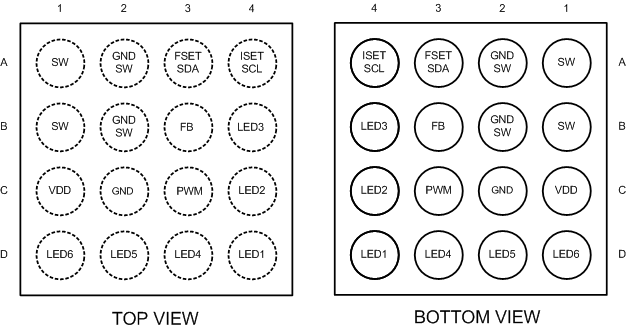SNVSA15B December 2013 – December 2015 LP8557
PRODUCTION DATA.
- 1 Features
- 2 Applications
- 3 Description
- 4 Revision History
- 5 Device Comparison Table
- 6 Pin Function and Configurations
-
7 Specifications
- 7.1 Absolute Maximum Ratings
- 7.2 ESD Ratings
- 7.3 Recommended Operating Conditions
- 7.4 Thermal Information
- 7.5 Electrical Characteristics
- 7.6 Boost Converter Electrical Characteristics
- 7.7 LED Driver Electrical Characteristics (LED1 To LED6 Pins)
- 7.8 PWM Interface Characteristics (PWM Pin)
- 7.9 Logic Interface Characteristics (PWM, FSET/SDA, ISET/SCL Pins)
- 7.10 I2C Serial Bus Timing Parameters (SDA, SCL)
- 7.11 Typical Characteristics
-
8 Detailed Description
- 8.1 Overview
- 8.2 Functional Block Diagram
- 8.3 Feature Description
- 8.4 Device Functional Modes
- 8.5 Programming
- 8.6 Register Maps
- 9 Application and Implementation
- 10Power Supply Recommendations
- 11Layout
- 12Device and Documentation Support
- 13Mechanical, Packaging, and Orderable Information
6 Pin Function and Configurations
YFQ Package
16-Pin DSBGA

Pin Functions
| PIN | TYPE (1) | DESCRIPTION | |
|---|---|---|---|
| NAME | NO. | ||
| FB | B3 | A | Boost feedback pin. The FB and OVP circuitry monitors the voltage on this pin. |
| FSET/SDA | A3 | I/O | Dual function pin. When I2C is not used (for example, BRTMODE = 00b), this pin can be used to set ƒSW and/or ƒPWM by connecting a resistor from this pin to a ground reference. When I2C is used (for example, BRTMODE = 01, 10 or 11), connect this pin to an SDA line of an I2C bus. The LP8557 "PWM Only" device option uses this pin as an FSET pin. LP8557I "PWM and I2C" device option uses this pin as an SDA pin. |
| GND | C2 | G | Ground pin. |
| ISET/SCL | A4 | I | Dual function pin. When I2C is not used (for example, BRTMODE = 00b), this pin can be used to set the full-scale LED current by connecting a resistor from the pin to a ground reference. When I2C is used (for example, BRTMODE =01, 10, or 11), connect this pin to an SCL line of an I2C bus. The LP8557 "PWM Only" device option uses this pin as an ISET pin. LP8557I "PWM and I2C" device option uses this pin as an SCL pin. |
| LED1 | D4 | A | LED driver – current sink terminal. If unused, this pin may be left floating. |
| LED2 | C4 | A | LED driver – current sink terminal. If unused, this pin may be left floating. |
| LED3 | B4 | A | LED driver – current sink terminal. If unused, this pin may be left floating. |
| LED4 | D3 | A | LED driver – current sink terminal. If unused, this pin may be left floating. |
| LED5 | D2 | A | LED driver – current sink terminal. If unused, this pin may be left floating. |
| LED6 | D1 | A | LED driver – current sink terminal. If unused, this pin may be left floating. |
| PWM | C3 | I | PWM input pin. |
| SW | A1, B1 | A | A connection to the drain terminal of the integrated power MOSFET. |
| SW_GND | A2, B2 | G | A connection to the source terminal of the integrated power MOSFET. |
| VDD | C1 | P | Device power supply pin. |
(1) A: Analog Pin, G: Ground Pin, P: Power Pin, I: Digital Input Pin, I/O: Digital Input/Output Pin